How to Transform a Vintage Vanity into Nightstands
Here at reinvented delaware, we love to come across unwanted items like this vintage 1940’s vanity. Today I want to share how to transform this vintage vanity into nightstands!
Let’s get started!

Friendly Neighbors
I know, I know, this vanity is upside down on my workbench! As usual, the camera came out a bit late in the project! But not until after I lifted the vanity up on the workbench!
Our neighbor had this piece and wanted to get rid of it. My hubby had cleared his driveway of snow several times and the neighbor wanted to pay him back in someway and offered this 1940’s vanity. Hubby said thank you very much 😉
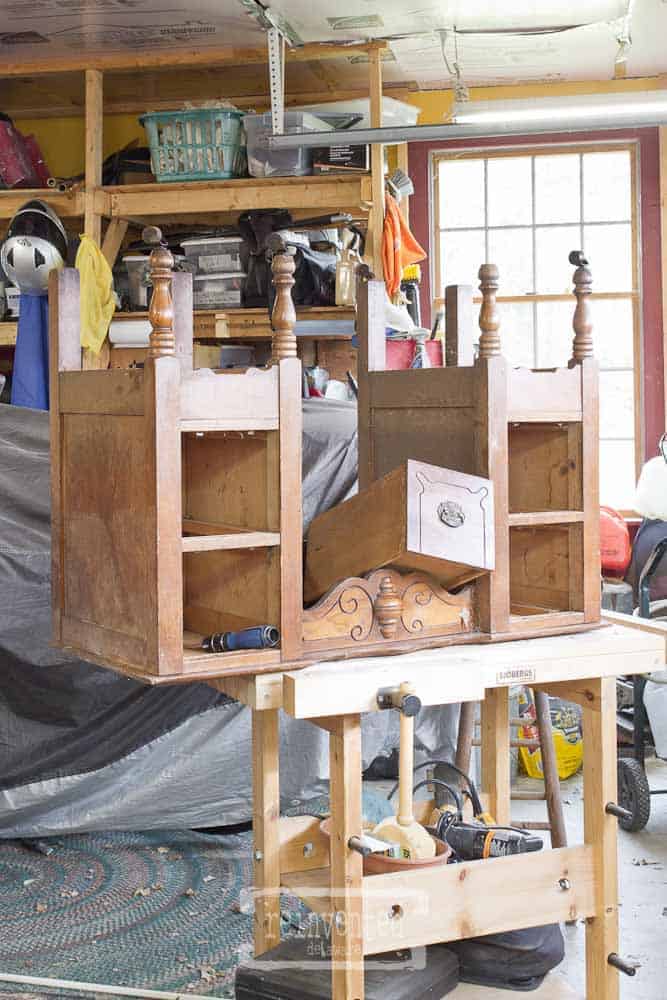
Remove the Top
The first step is to remove the top. Pull out the drawers and you will be able to see the screws that attach the top to the base. They are usually flat head screws and can be a challenge to loosen. Be patient and apply even, downward pressure as you turn the screw. You don’t want to ruin the flat head of the screw!
I removed the drawer pulls while the screwdriver was handy. A sandwich baggie comes in handy for keeping all the hardware together!
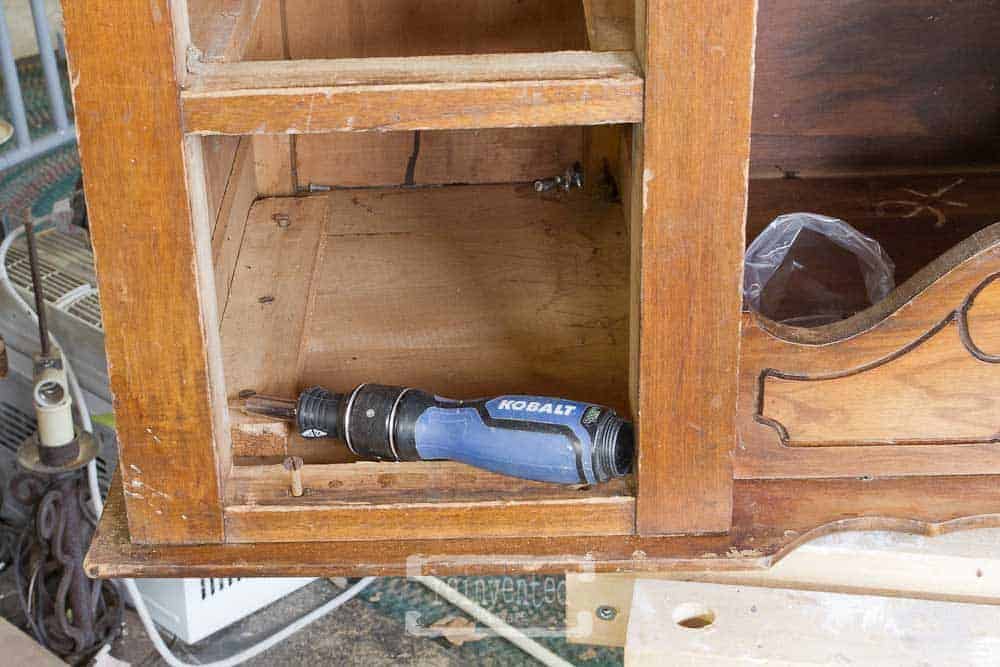
This vanity top was also secured with long nails. Using the chisel, I gently pried and loosened the nails. This took some time – I didn’t want to ruin the top. We have plans for the top of the vanity for another project!
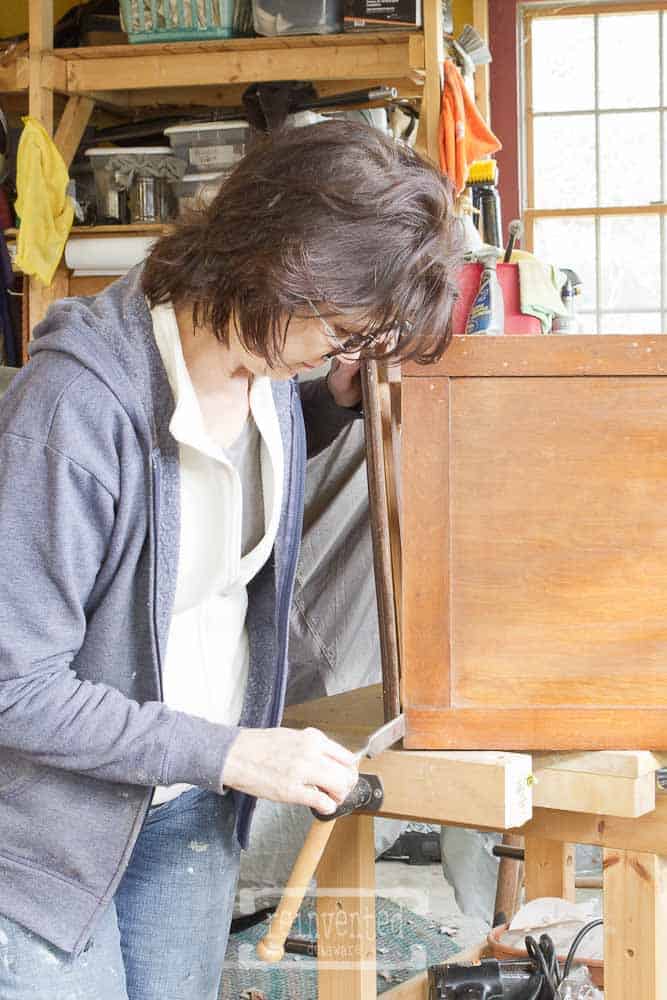
Once the top is removed from the base of the vanity, tap on the sharp end of the nail to remove it completely.
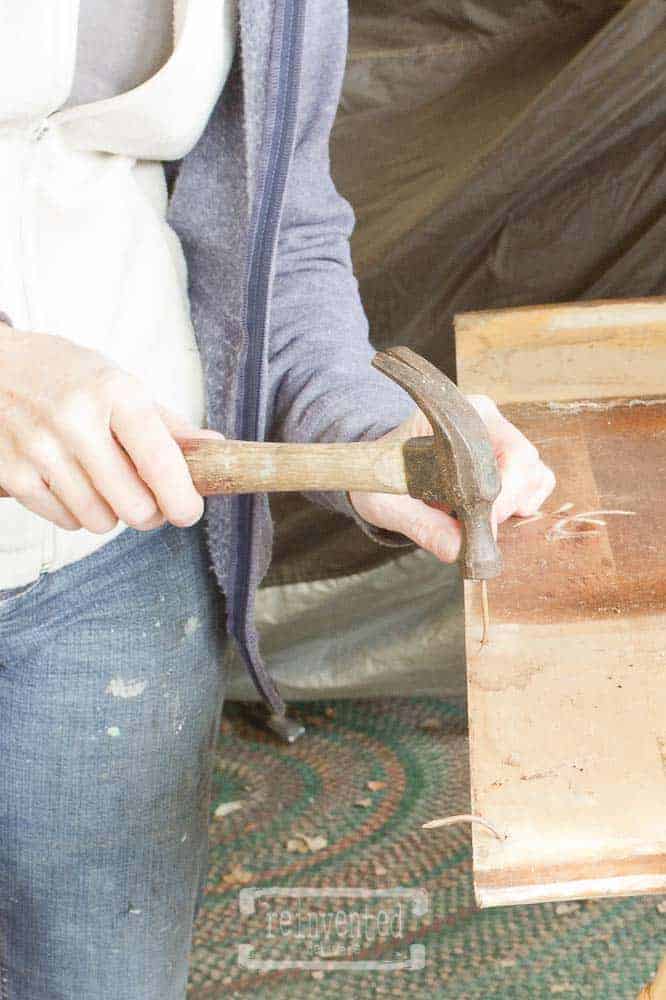
Separate the Sections
The back of these vintage vanities often have a piece of wood that join the two sections. I used the chisel and hammer to loosen and pry it away from the sections with drawers. These leftover pieces of wood are stashed away. They come in handy with repairs for many of the projects we do. In fact, we used the back piece to repair part of this vanity! Keep reading….
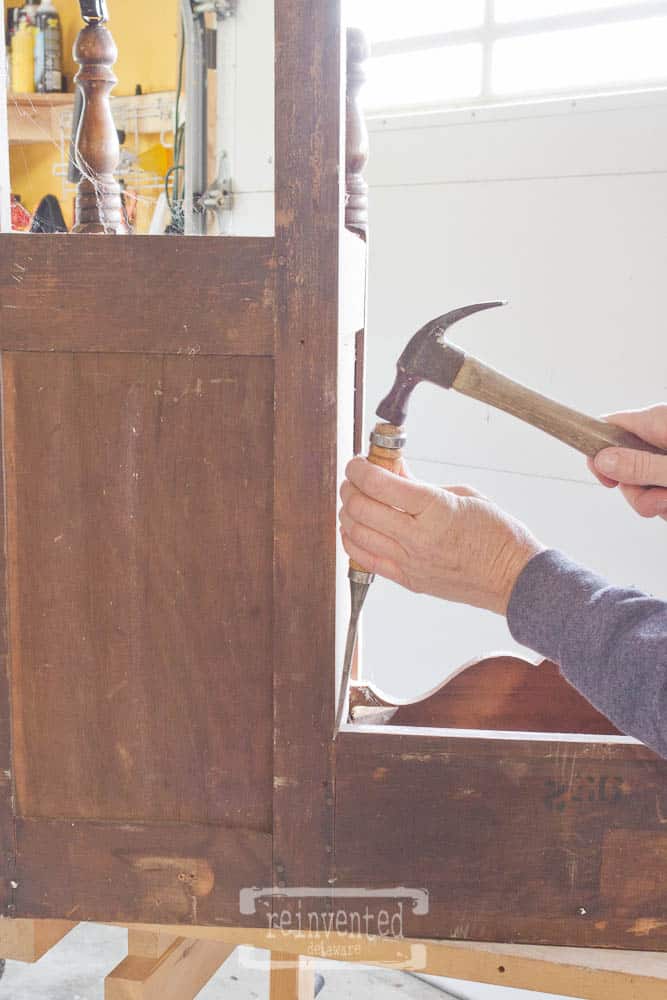
The decorative front piece was removed the same way. And of course it was stashed away for a future project! You never know when you might see that piece pop up again!
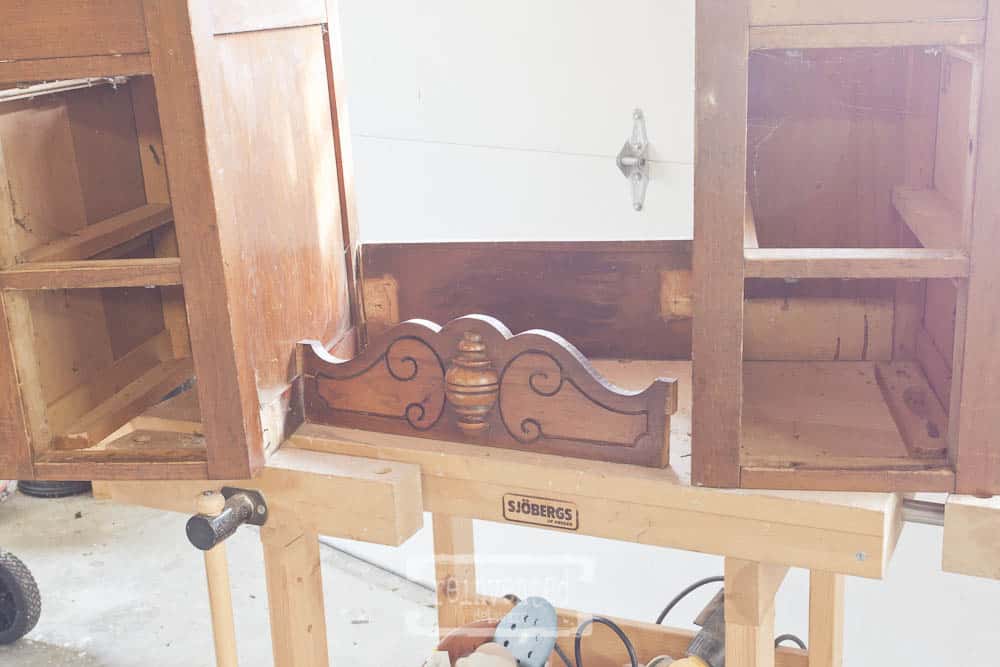
Wood Filler is Your Friend
The holes that the wood pieces left were filled with Elmers Wood Filler. I use a couple of different methods for filling holes like this including Bondo and handmade wood filler using wood glue and saw dust. The Elmer’s Wood Filler was handy and quick.
Here you see that I used a craft stick to press the filler into the holes. When it was completely dry, it got a good sanding!
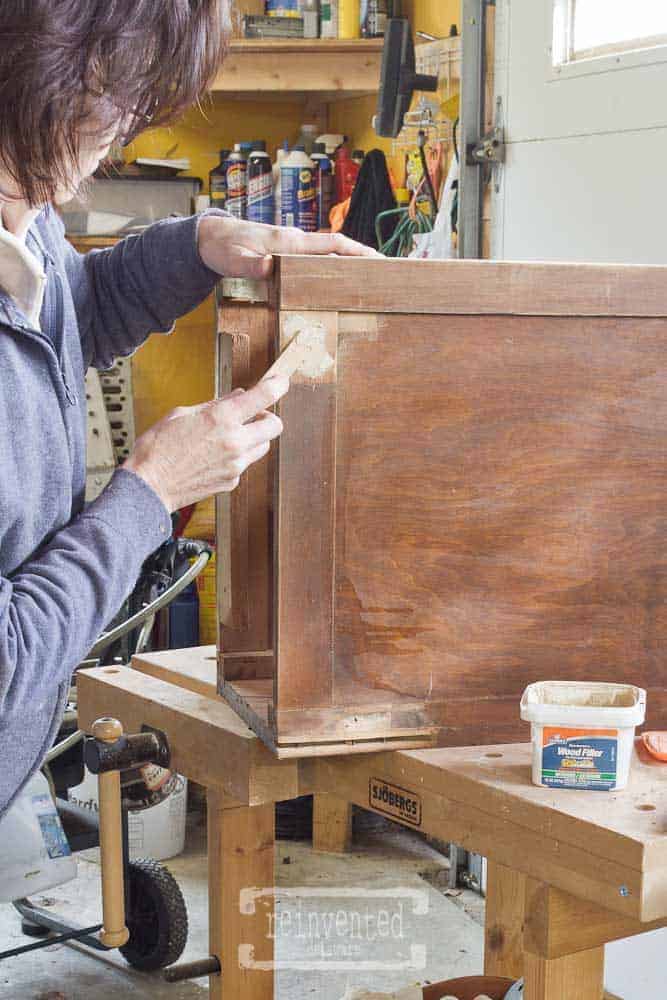
Repairs and Cleaning
Look very closely at the back legs on the vanity – see that little piece of light colored wood on the back legs? Let me tell you about that – some of the wooden casters were missing. The best way to remedy this problem (since most of us don’t have replacement wooden casters just lying around) is to move any casters on the back legs to the front legs that have missing ones. My hubby cut a piece of wood to bring the back legs up to the correct height due to the missing casters. The pieces were attached with wooden dowel rods and glue. The gaps where the new piece meets the old piece were filled with Elmer’s Wood Filler and sanded smooth. Once the piece is painted, you will never know the difference!
A good vacuuming with the shop vac and then a scrubbing with my favorite cleaner, Simple Green mixed with a bit of warm water. I love using micro-fibre cloths – they seems to grab the dirt off of the piece!
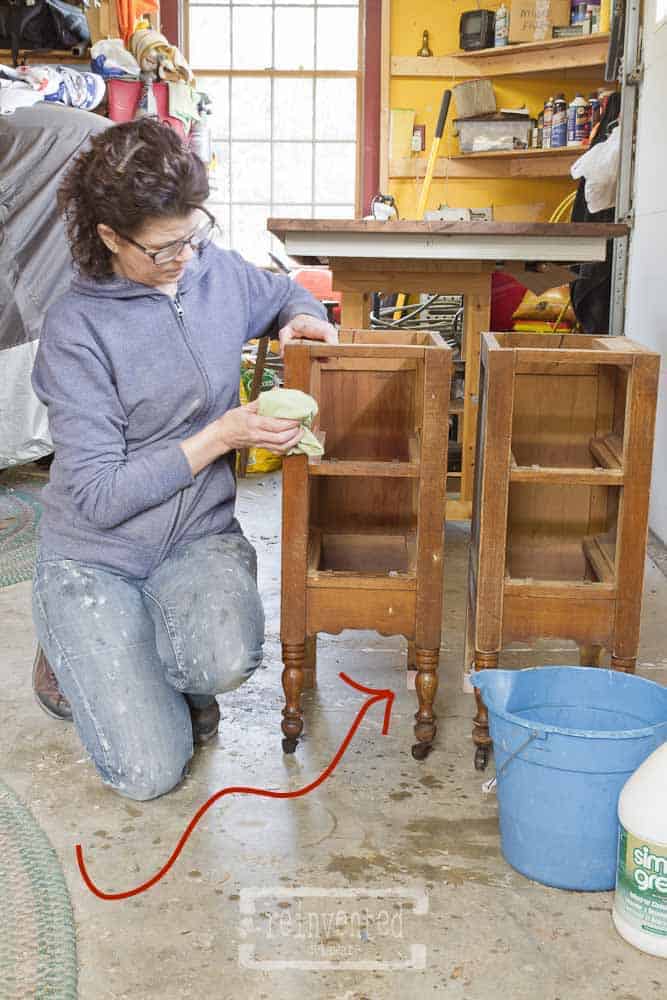
The Fun Part – Painting
I am a huge Miss Mustard Seed Milk Paint fan! And I love mixing the colors so that the pieces we create are unique. This combination of three parts Aviary and one part Schloss made a gorgeous blue/gray.
You can read how I mix this paint here. I usually mix the paint before I start cleaning the piece. That gives the dry milk paint plenty of time to soak up the warm water.
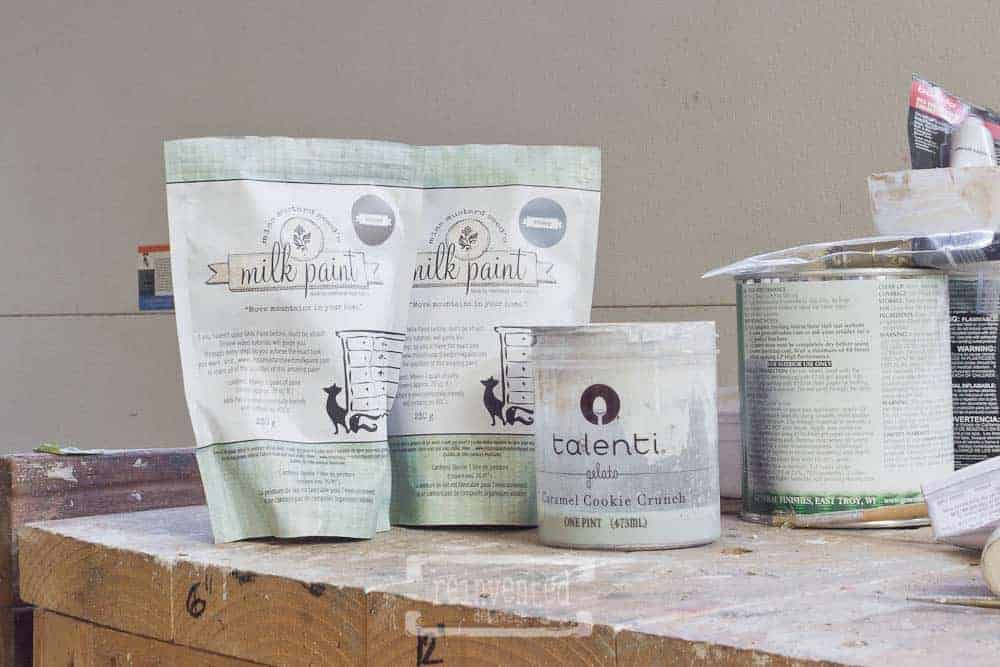
The First Coat Can be Scary!
Don’t panic! Just let it dry and press on my friend! It will get better with the second coat, I promise 😉
Also, I forgot to mention another repair my hubby made. See the top left drawer and bottom right drawer? They both were missing a chunk of wood so my hubby used the back piece that I removed earlier to cut new pieces to replace the missing pieces. The back piece was perfect for this repair because the thickness of the wood was the same thickness as the drawer fronts! Also, since it was an old piece of wood, it had aged just like the drawer fronts had. Perfect for the distressing part of the project!
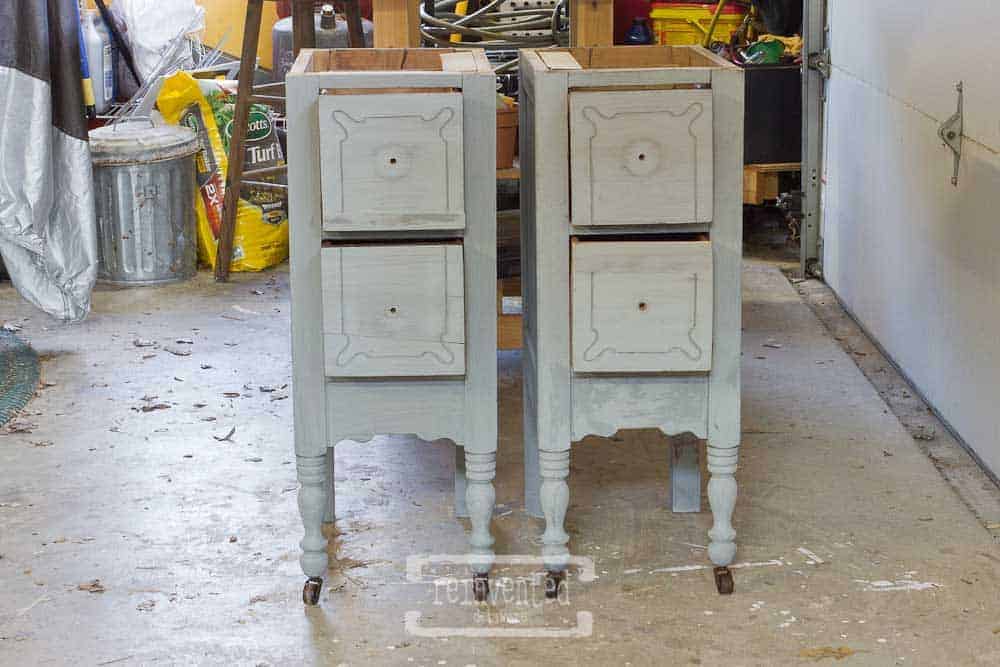
Distressing and Aging
Using the side of a flat knife blade, I gently scrape and chip off the paint. I cannot stress enough how gently I do this step. It can look like I am ruining the furniture, but believe me I am not! This method, in my opinion, gives such an authentic aging to the piece. You can also use 220 grit sandpaper to distress as well. I also go over the whole piece with the 220 grit sandpaper. This step creates such a smooth finish
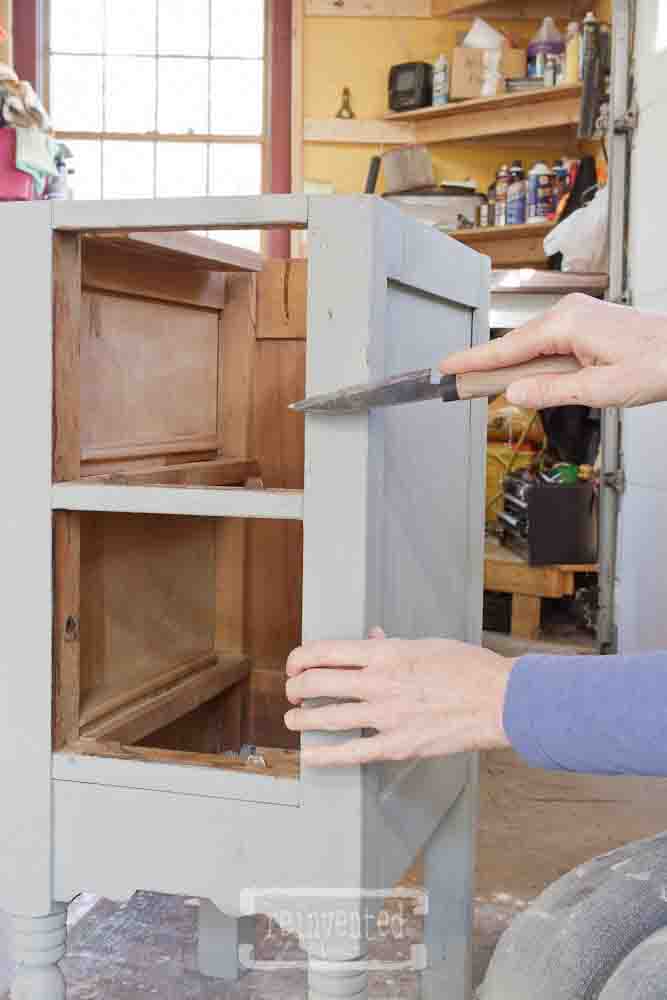
Distress on the high spots, edges and places where natural wearing would happen. The amount you distress is completely up to you. I try to imagine the age of the piece and the use it would have taken over the years. Imagine someone touching a piece of furniture at they walk by it, opening the drawers or accidently kicking it!
Give the pieces a good once over with the shop vac and a clean, dry micro-fiber cloth to remove the dust created by distressing the piece.
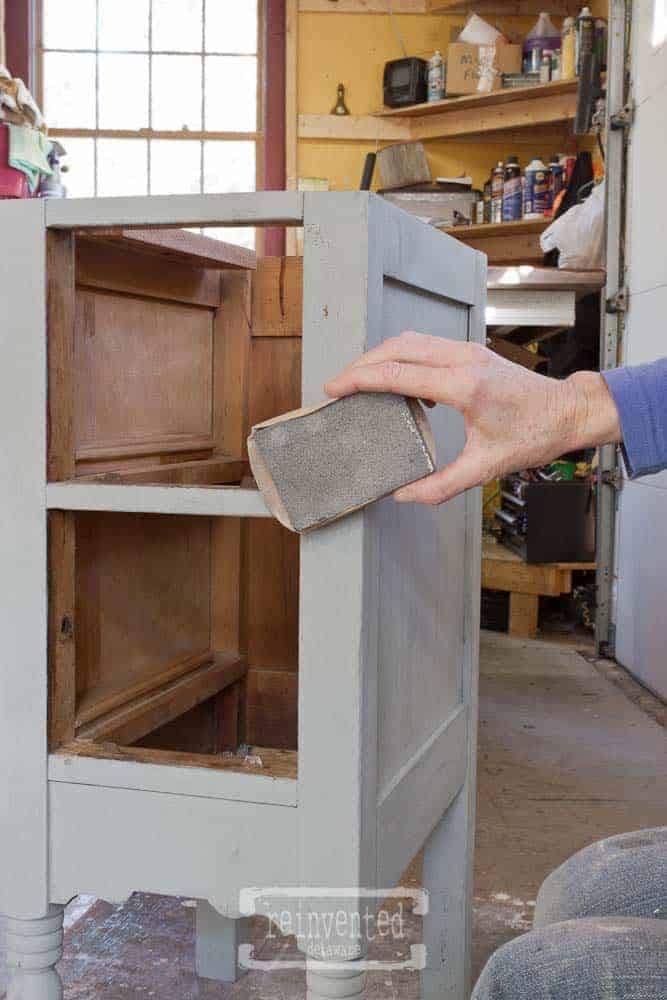
Moisturize and Seal
Miss Mustard Seed Hemp Oil is a great choice if you are going for the authentic age in a piece. The milk paint just soaks it up and the wood seems to love it too! Think how good it feels on your skin when you clean it thoroughly and then moisturize it ;). That is what this lovely little stand gets to experience 🙂
I brush it on and then wipe off the excess. Be sure to work it into all the nooks and crannies. I also gave the casters a good coat of the hemp oil.
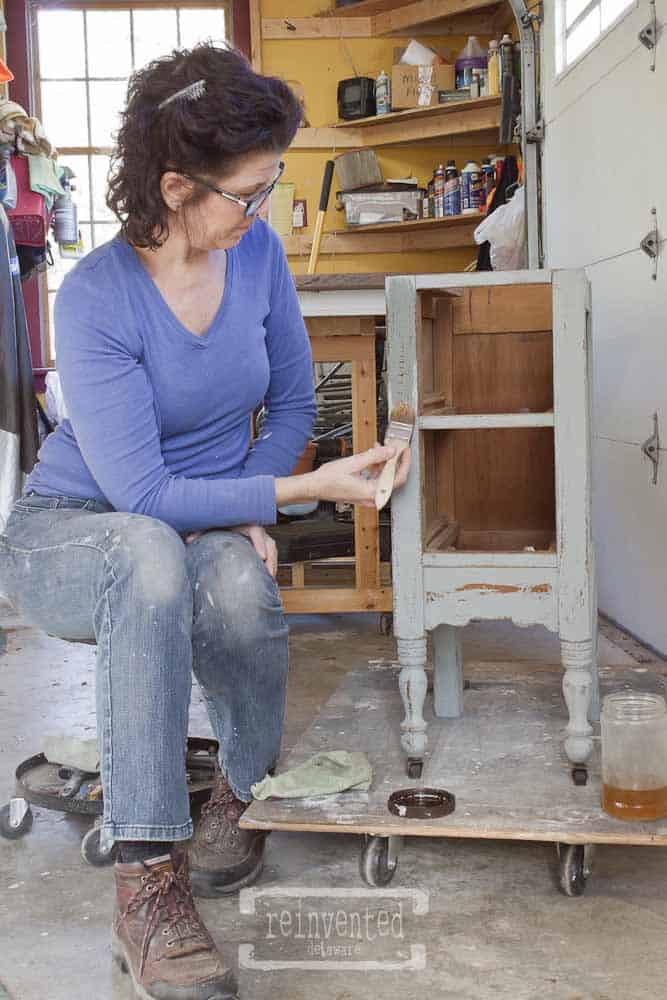
Finishing Touches
A wire brush gave the hardware a good cleaning.
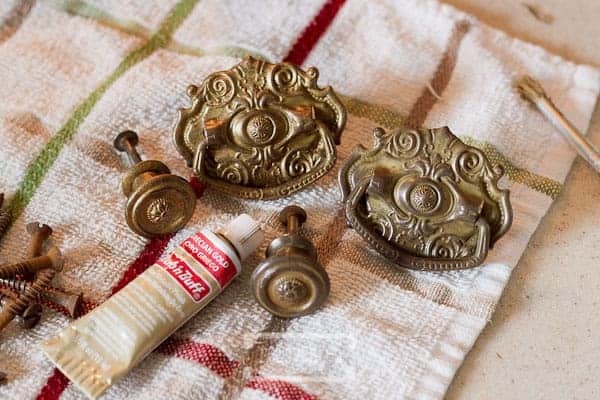
I first heard about Rub ‘n Buff from my Insta-friend Jenn over at Eight Hundred Furniture. She demonstrated how to use the product in her Insta-Stories so I though I would give it a try! I am hooked on this stuff!
I applied a thin layer of Rub ‘n Buff in Grecian Gold all over the drawer pulls using a stiff artist paintbrush. This step was quick and it didn’t take long to dry.
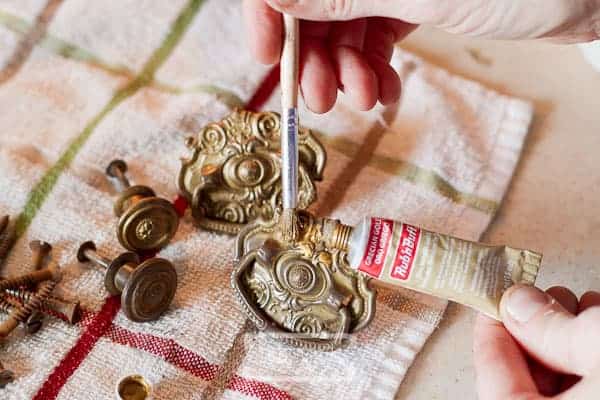
To soften and age the finish, I used #0000 steel wool and buffed the drawer pulls. See the one in the front? It looks like it aged perfectly!
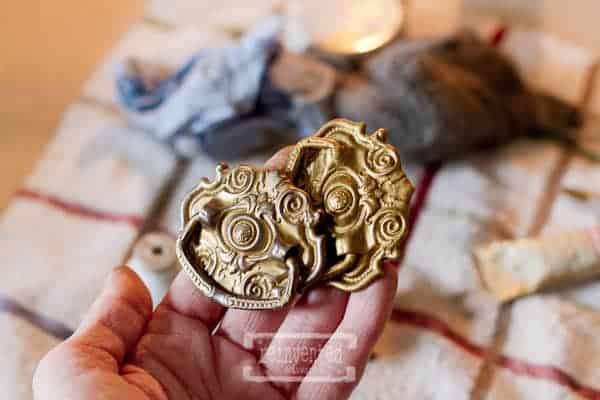
Look at the Lovelies!
Here are the finished nightstands! Don’t they make a gorgeous pair?
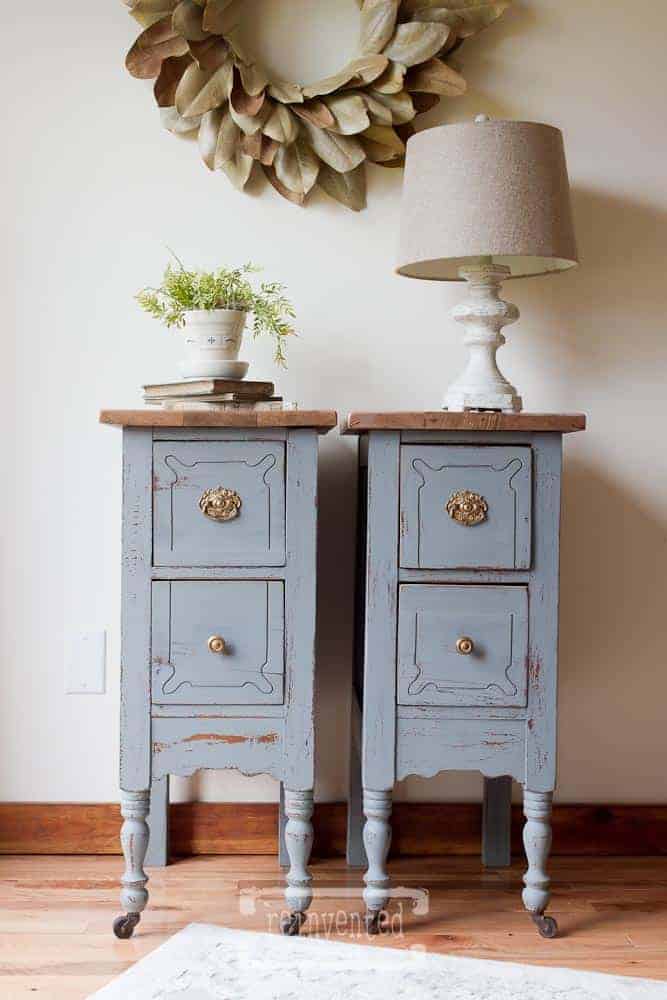
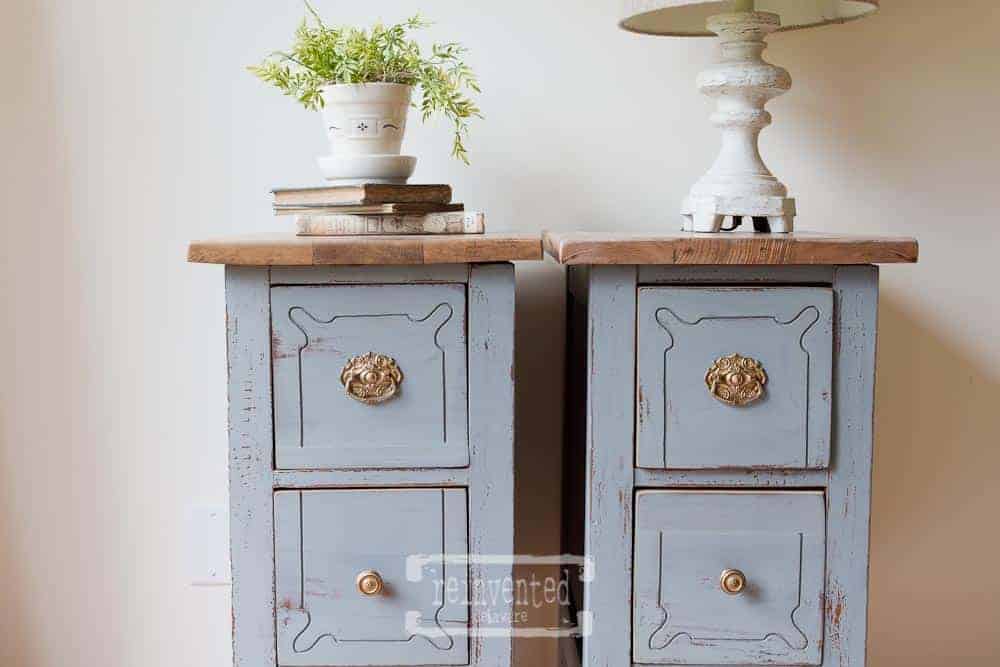
You are probably wondering where the wood tops came from! Hubby built them from industrial pallet wood scraps leftover from one of the farm tables we have reinvented! You can see a couple of those tables here! He does his work at night in his workshop and my camera never seems to make it out there when he is building! One of these days…….
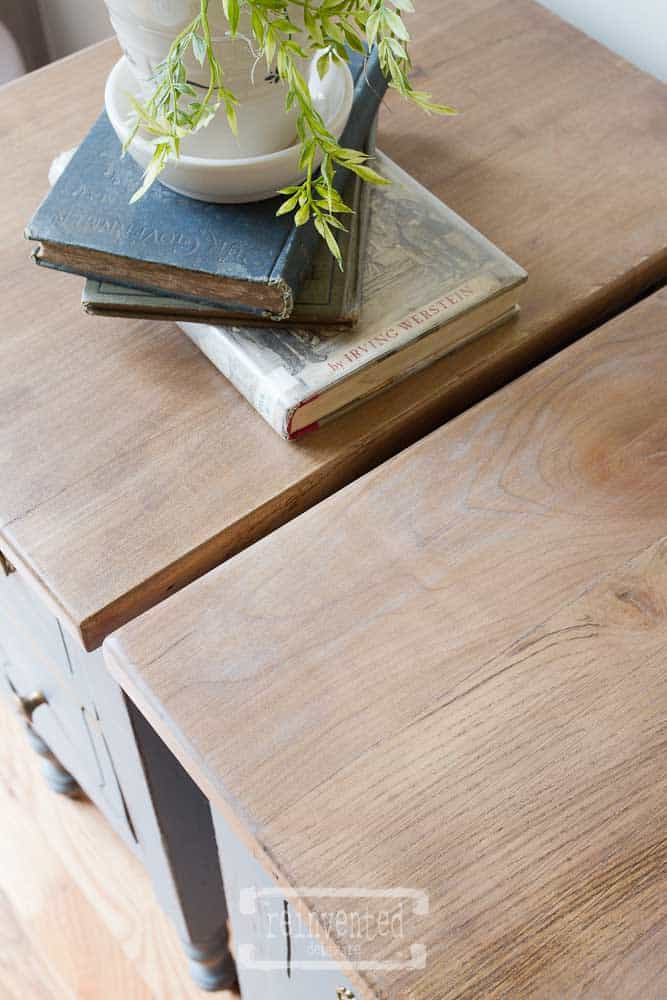
I lined the drawer interior bottoms with vintage dictionary pages. You can see the step by step tutorial here.
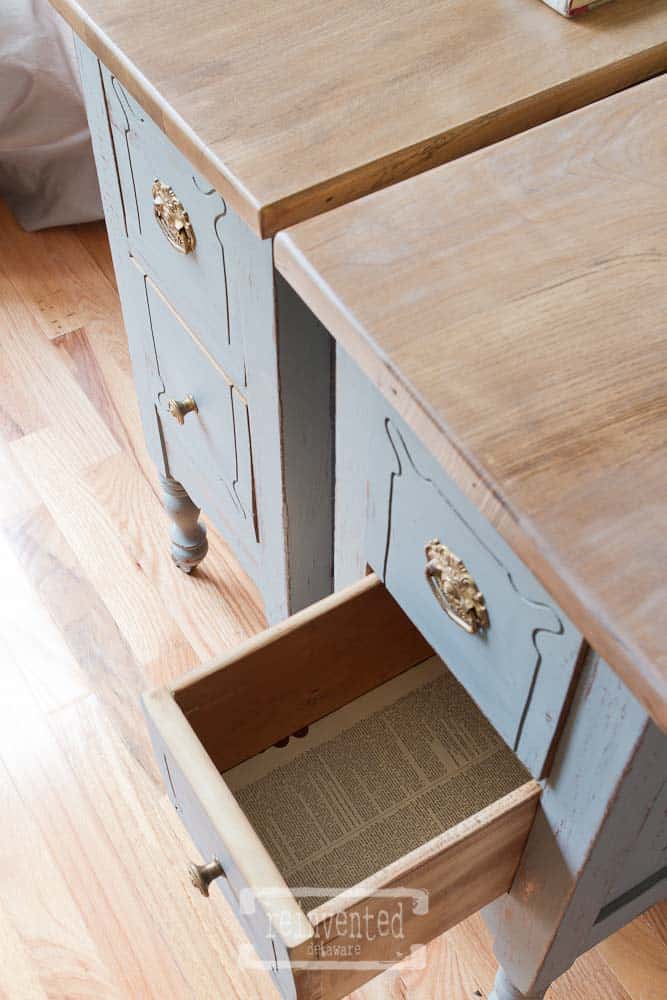
The hardware is gorgeous! I really loved using the Rub ‘n Buff on the drawer pulls.
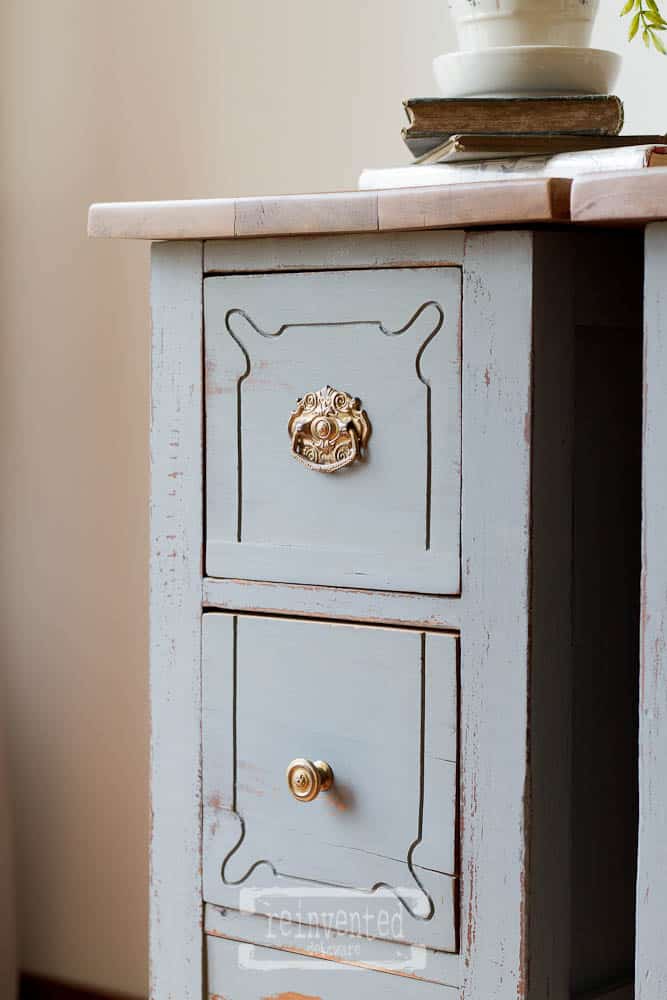
Remember the repair we made to the back legs of the stands? You can’t even tell they were shorter than the legs with casters! And check out those beauties! My heart beats a bit faster when I see casters on furniture! Especially with wooden wheels 🙂
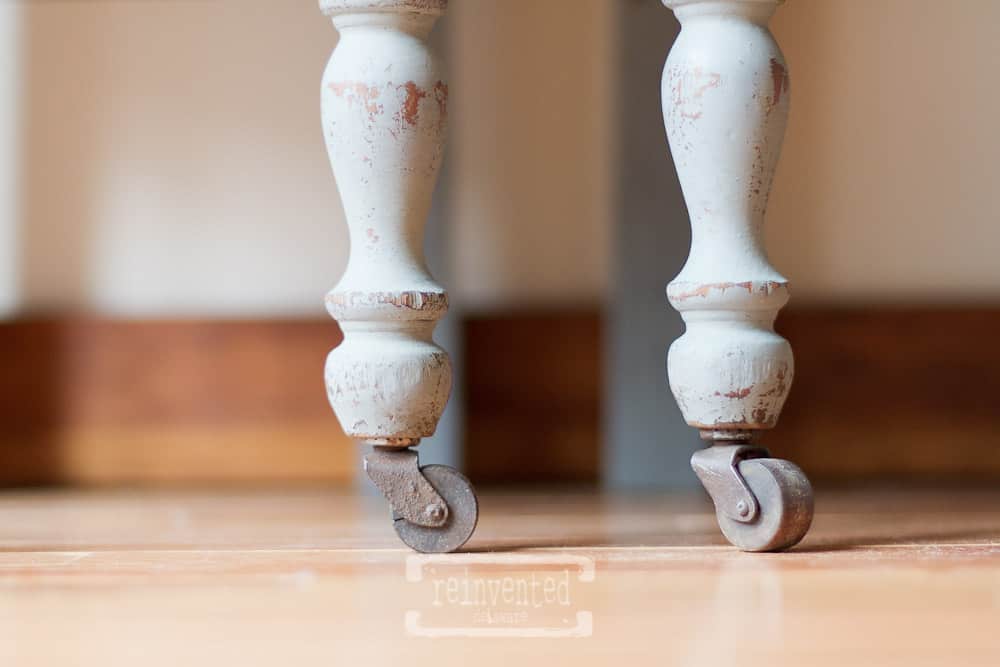
Aren’t these vintage vanity nightstands just the prettiest?? They will look lovely in someone’s home – as bedside stands or as sofa end tables.
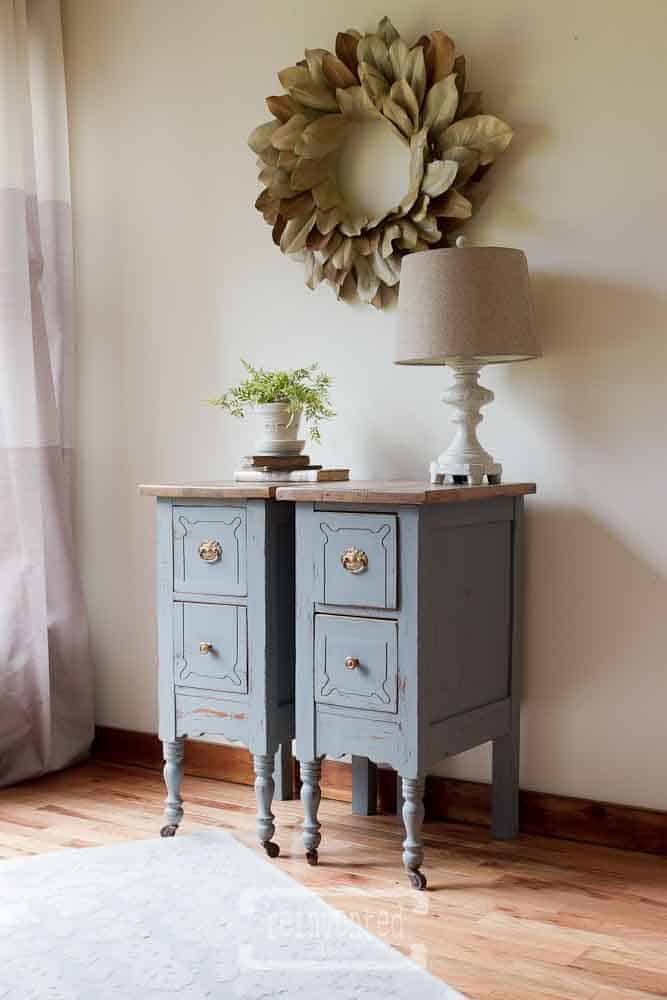
Unbelievable Transformation!
Can you believe where we started with this project? We had furniture parts all over the place! It is unbelievable what a little TLC can do for furniture!
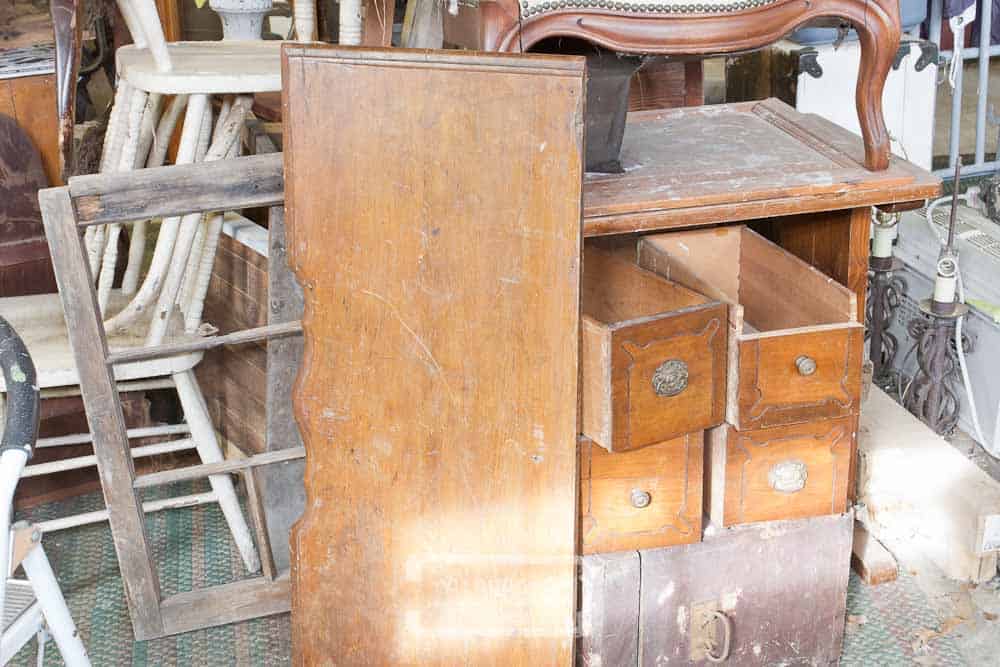
Join the Reinventing Fun!
Thanks for popping in watch how to transform a vintage vanity into nightstands!
Pin this image for inspiration!
You can follow along our reinventing journey on Instagram and Facebook! We would love to have you join us! Our email subscription tab is in the sidebar – subscribe so you don’t miss any of the fun projects!

See you soon!

Very well written. I wonder how much licking was completed during this transformation
Believe me – too much!! Our little fella loves scratching and licking!! ??
Hi Cindy! I’m glad to meet you through Thistle Key Lane! There’s a really nice group of ladies I’ve met through blogging, and Michelle is wonderful. Your work is beautiful! These night stands are simply stunning and so masterfully reinvented. I’ve been wanting to find night stands for our guest room, and I’m really set on the idea of doing something like this now. My husband does most of our woodworking, but I like to…shall we say…provide input! 😉 Pinning this to my DIY furniture/decor board!
Omgoodness Crissy!! This is the first time anyone has pinned something from my blog!! Well except for my husband and me ?? Thank you so much for the kind words! I hope to get to know many new friends in the blogging world! I would love to know if you get an opportunity to do a project like the nightstands – it is such a fun project! Thanks again for reading, commenting and pinning?
These came out SO great, Cindy! I am also a rub n buff fan – that stuff works miracles!
Rub n Buff for the Win! Thanks for stopping by Janet!
Cindy – You always put together such fabulous tutorials and “how to” posts. This one was no exception. I really appreciated how you walked the reader through each step you took and took photos. Of course, the end result is unbelievable! These night stands are absolutely stunning!
We were pretty happy with the results too Anna. So glad you enjoyed the tutorial 🙂